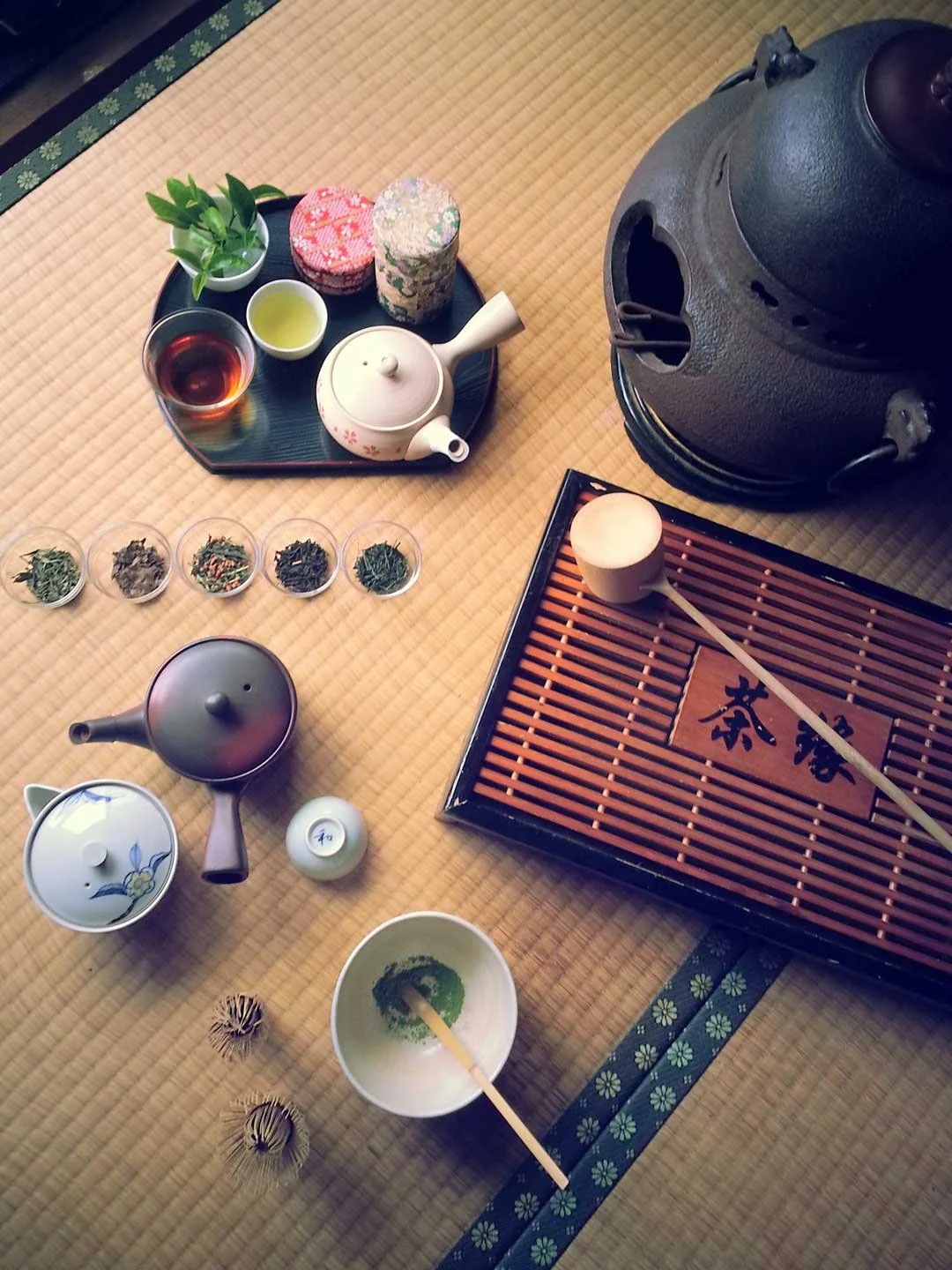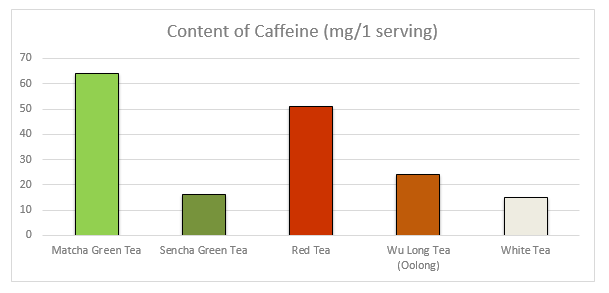Caffeine in Tea: The Whole Story
It's time to dispel some rumors about caffeine in tea by answering some basic questions:
How much Caffeine is in tea?
Does green tea have more or less than red (called black in the West)?
And what is decaffeinated tea all about?
We'll cover all that in more detail in this post.
So you'll know exactly how to maximize, or minimize, your caffeine consumption in tea.
Does Tea Have Caffeine?
All tea has caffeine, as all tea comes from the same plant: Camellia Sinensis.
What we call herbal teas are not actually tea, but rather tisanes.
By the way, if you have trouble sleeping, we compiled a helpful list of herbal teas that help you sleep.
So whether you are talking about:
White tea
Black tea
Red tea (known as Black tea in the West)
Green
Or Wu Long (Oolong)...
As long as it's tea, then it has caffeine.
Here are examples of some common teas and their approximate caffeine content:
And it's no wonder the Camellia Sinensis has caffeine.
It is a natural insecticide that protects the plant from bugs.
For us, caffeine lends its alkaline bitter taste that's present in tea.
Coffee has about 100mg of caffeine per cup.
You'd need to drink 4 full cups of black tea, or 6 full cups of green tea to achieve that number.
This means that your typical green tea has 1/6th the amount of caffeine as coffee. This is a good start, but this number can drop far lower.
What about Decaffeinated Tea?
It's true.
Tea can be decaffeinated.
To be considered decaffeinated, the number must be reduced to 99% or more. Chemical solvents such as methylene chloride or ethyl acetate can be used by soaking the leaves.
As ethyl acetate is naturally found in the leaf, this method is considered "natural."
For those with severe reactions to caffeine, decaffeination is an effective route but it comes at a cost…
Namely that 'real' tea is never decaffeinated.
Only the cheaper-supermarket stuff.
Extra info: Actually, there is no demand in Asian tea-producing countries like Japan and China when it comes to chemically decaffeinated tea. People drink tea with its caffeine or herbal tea which is naturally a non-caffeinated drink.
Real tea is like wine.
Just as it sounds silly to drink fine French Bordeaux that is non-alcoholic…
It is just as uncommon (if impossible) to find genuine terroir sourced tea that has been fussed with in the chemistry lab to remove a property inherent in all tea.
But, all is not lost.
One can reduce the amount of caffeine in their cup following simple selection techniques and brewing methods.
Choosing the Right Tea
There are three general factors that tend to hold true with caffeine in tea.
Though, it's worth noting that these are general factors, and can vary.
1 - The Age of the Leaves
New buds have more caffeine per gram than the first leaf, which has more than the second, and so on.
This is because the plant invests more nutrients in the newer leaves.
For example, if you are looking for a less caffeinated tea, you can go for:
A green tea like Hou Kui (Monkey King), which is made up of larger leaves.
A green tea like Hojicha, which uses older tea leaves and twigs.
However, a tea like Bi Luo Chun (Green Snail Spring), made of buds only, will have a higher amount of caffeine.
2 - The Processing of Tea
Tea can be more or less oxidized.
Oxidation in tea is the same process that turns apples brown when you cut into them.
It can change the flavor, aroma, and color of a tea.
Producers choose how much they want to oxidize tea leaves depending on the kind of tea they want to create.
Red tea (known as Black tea in the West) is 100% oxidized.
This means it has a higher caffeine content than the green tea version which is 0% oxidized.
So a strong red tea will give more of a kick than a green tea, in general.
Other steps of tea processing can also influence a tea’s concentration of caffeine. For example, some of the caffeine in tea leaves is lost during the roasting process of Wu Long (Oolong) and Bancha teas.
Plus, leaves that grow in shaded areas or that are purposely shaded before harvesting have relatively higher caffeine levels.
This is the case for Japanese Gyokuro and Matcha green teas.
3 - The Harvesting Time
The amount of caffeine in new leaves also varies depending on the season.
Summer and fall tend to produce higher levels of caffeine than spring and winter.
That is because the tea plants grow more during these seasons.
For example, a first flush and a second flush Sencha (regular Japanese green tea) will have more caffeine than a third flush one.
First flush tea is made from the very first leaves that grow after the winter dormancy period (April/May), while second flush tea is made from leaves that grow later in the season (June/July). Third flush tea is harvested in late summer or early fall, when the leaves are at their largest.
So even within the same category of tea (say green tea), you can find different levels of caffeine content like with Sencha.
Brewing Techniques
We've seen that various factors have an effect on the concentration of caffeine in tea leaves.
Though, we don't eat the leaf.
So your brewing technique will change how much caffeine you actually consume.
Let's think about our coffee comparison.
If we're brewing to minimize the amount of caffeine in our tea…
Then we've already started with green tea, which has about 16mg of caffeine per individual cup.
As I mentioned before, we'd need to drink 5 more cups to get to our 100mg of caffeine in one cup of coffee.
Caffeine is one of the first water-soluble chemicals that leach out during steeping. And we can exploit that to further minimize the caffeine.
By pre-steeping our tea for 30 seconds in hot water, and then disposing of it, we've depleted the caffeine in the cup by a further 50-70%!
This means our one cup of green tea now has a maximum of 8mg per cup, but probably less.
This is where decaffeinated coffee falls, by the way.
It's also less than a Hersey chocolate bar, which clocks in at 9mg per bar.
With correct brewing methods, we can reduce the caffeine per cup of green tea to less than 8mg.
(Which is the same range as decaffeinated coffee).
In Closing
Whether you want...
To maximize your caffeine by favoring teas made with young buds and leaves, or...
To lower the caffeine content of your favorite red tea
You can manage your caffeine intake without resorting to chemically altered flavorless supermarket teas.
This is one of the huge advantages of tea over wine.
You can still visit the Terroirs of distant lands and mountain peaks with your tongue…
While easily tailoring the active ingredients however you'd wish.
But decaffeinating tea is one trick.
And it so happens I have more.
Let me share them with you.
Have a look at our previous article to learn 7 delicious Tea Hacks you can do today!
MORE ON TEA






